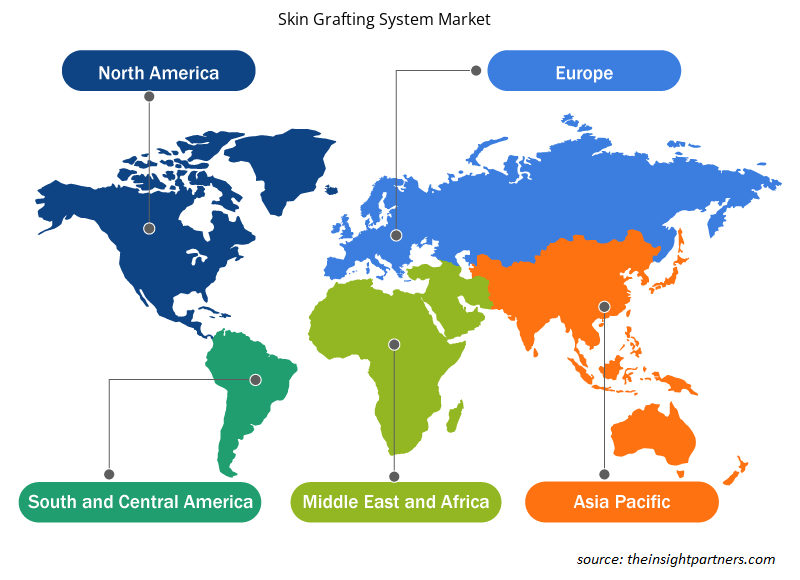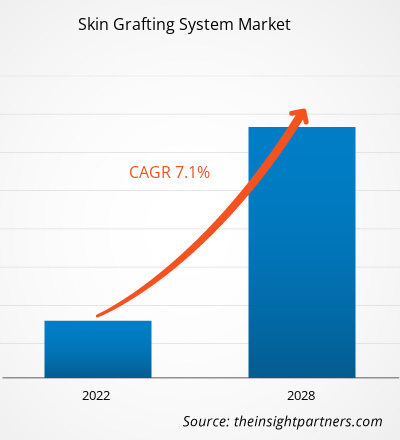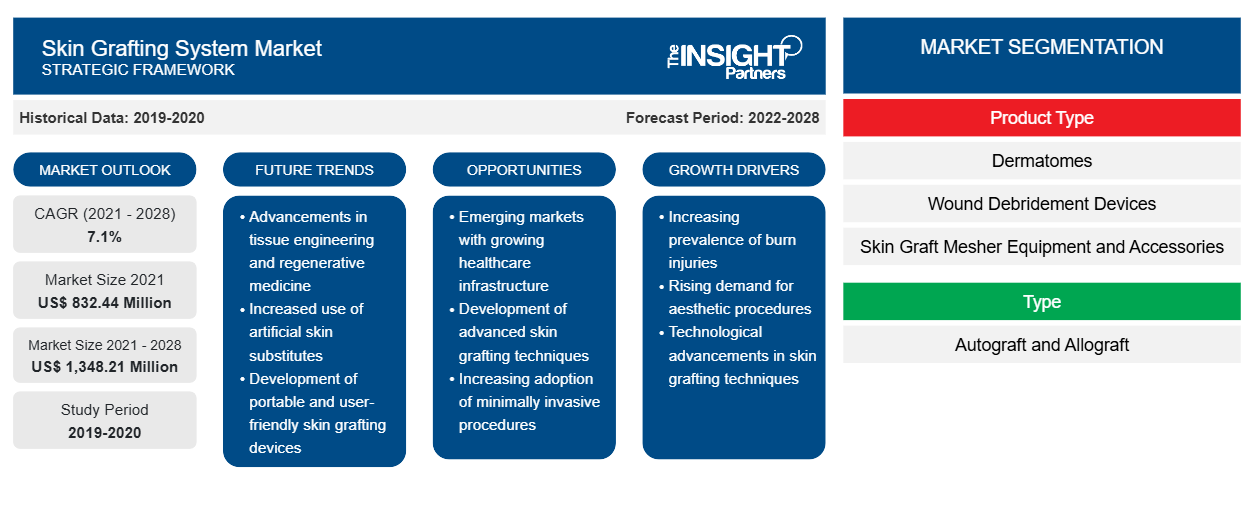Si prevede che il mercato dei sistemi di innesto cutaneo raggiungerà 1.348,21 milioni di dollari entro il 2028, rispetto agli 832,44 milioni di dollari del 2021; si stima che crescerà a un CAGR del 7,1% nel periodo 2021-2028.
I sistemi di innesto cutaneo sono una serie di dispositivi, attrezzature, strumenti e materiali di consumo utilizzati nel processo di innesto cutaneo, come la raccolta del campione, la formazione della maglia e l'innesto finale. Alcune fasi incluse nel processo di innesto cutaneo consistono nella raccolta dell'innesto cutaneo (utilizzando il dermatomo), la mesh della pelle (utilizzando l'attrezzatura e gli accessori della mesh della pelle), lo sbrigliamento della ferita (utilizzando i dispositivi di sbrigliamento della ferita) e tutti i materiali di consumo e gli strumenti correlati nel processo di innesto cutaneo. L'innesto cutaneo viene eseguito su vari tipi di ferite, come ustioni, ferite croniche, ferite traumatiche e ferite chirurgiche. Gli innesti cutanei promuovono il processo di guarigione nei casi in cui il processo di guarigione può essere estremamente lento o trascurabile.
Il mercato dei sistemi di innesto cutaneo è segmentato in base al tipo di prodotto, tipo, tipo di ferita, utente finale e area geografica. Il mercato, per area geografica, è ampiamente segmentato in Nord America, Europa, Asia Pacifico, Medio Oriente e Africa e Sud e Centro America. Il rapporto di mercato sui sistemi di innesto cutaneo offre approfondimenti e analisi approfondite del mercato, sottolineando parametri quali dimensioni, tendenze e dinamiche del mercato; progressi tecnologici nel mercato; e l'analisi del panorama competitivo dei principali attori del mercato nel mercato dei sistemi di innesto cutaneo.
Personalizza questo report in base alle tue esigenze
Riceverai la personalizzazione gratuita di qualsiasi report, comprese parti di questo report, o analisi a livello nazionale, pacchetto dati Excel, oltre a usufruire di grandi offerte e sconti per start-up e università
-
Scopri le principali tendenze di mercato in questo rapporto.Questo campione GRATUITO includerà analisi di dati che spaziano dalle tendenze di mercato alle stime e alle previsioni.
Si prevede che alcuni fattori, come l'aumento dei casi di ustioni, la crescente prevalenza di cancro della pelle e diabete e la crescente varietà di fonti di innesto cutaneo per il sistema di innesto, avranno un impatto significativo a breve, medio e lungo termine sul mercato del sistema di innesto cutaneo nei prossimi anni. Tuttavia, il costo delle procedure di innesto cutaneo ostacola la crescita del mercato. Il rapporto di mercato identifica opportunità e tendenze future del mercato che possono avere possibili impatti sulla crescita del mercato.
Approfondimenti di mercato
Aumento dei casi di ustioni
Le principali aree di applicazione degli innesti cutanei sono le ustioni e le infezioni cutanee. C'è stato un aumento del numero di decessi causati da ustioni. Secondo l'American Burn Association, nel 2016, negli Stati Uniti, ci sono stati 3.390 decessi civili dovuti a incendi, tra cui 2.800 decessi per incendi di strutture residenziali, 150 decessi per incendi di strutture non residenziali, 355 per incendi di veicoli e 85 per incendi esterni e non classificati diversi da incendi di strutture o veicoli. Le statistiche includevano oltre 14.650 feriti. Le statistiche hanno mostrato che ci sono stati 58.520 feriti tra i vigili del fuoco degli Stati Uniti in servizio tra il 2011 e il 2018. La National Fire Protection Association (NFPA) ha stimato che nel 2020 si sono verificati 1.388.500 incendi, che hanno causato 3.500 decessi civili e 15.200 feriti. La NFPA ha scoperto che, mentre il numero di decessi correlati agli incendi è diminuito del 46% dal 1980, c'è stato un aumento del 23% dal numero record di decessi del 2012, che era di 2.855, alla cifra attuale. I risultati della NFPA hanno anche concluso che gli incendi in case mono e bifamiliari hanno causato il 63,7% delle vittime civili e il 56,6% dei feriti, seguiti dagli incendi in appartamenti che hanno causato il 19,1% dei feriti nel 2020.NFPA) estimated that 1,388,500 fires took place in 2020, which caused 3,500 civilian deaths and 15,200 injuries. The NFPA found that while the number of fire-related deaths declined by 46% since 1980, there was an increase of 23% from the record low number of deaths in 2012, which stood at 2,855 to the present figure. The NFPA findings also concluded that one-and two-family home fire accounted for 63.7% of civilian casualties and 56.6% of injuries, followed by apartment fires which stood at 19.1% of injuries in 2020.
Allo stesso modo, secondo le statistiche dell'Organizzazione Mondiale della Sanità (OMS) pubblicate nel 2018, si sono verificati più di 180.000 decessi a livello globale a causa di ustioni. La maggior parte delle ustioni viene segnalata nei paesi a basso o medio reddito dell'Africa e del Sud-est asiatico. Ad esempio, l'OMS stima che un milione di persone in India subisca ustioni moderate o gravi ogni anno. Allo stesso modo, in Bangladesh, Colombia, Egitto e Pakistan, il 17% delle ustioni nei bambini porta a disabilità temporanee, mentre il 18% ha una disabilità permanente. Con l'aumento del numero di ustioni, la domanda di innesti cutanei per sostituire la toppa cutanea danneggiata è aumentata negli ultimi anni. Secondo le statistiche del National Burn Repository (NBR), nel 2016, circa 486.000 ustioni hanno ricevuto cure mediche. Oltre il 60% dei ricoveri ospedalieri correlati alle ustioni sono stati ricoverati in 128 centri ustionati. Inoltre, il costo delle cure è aumentato in tutto il mondo. Ad esempio, nel 2017, il National Health Services (NHS) del Regno Unito ha curato circa 15.000 pazienti con ustioni e il costo del trattamento è stato di oltre 24,94 milioni di dollari USA (ovvero 20 milioni di sterline). Analogamente, negli Stati Uniti, ogni anno, vengono spesi più di 7,9 miliardi di dollari USA per visite al pronto soccorso e cure ospedaliere per ustioni.NBR) statistics, in 2016, around 486,000 burn injuries received medical treatment. Over 60% of the hospitalizations related to burn injuries were admitted to 128 burn centers. Also, the cost of treatment increased worldwide. For instance, in 2017, the National Health Services (NHS), UK, treated ~15,000 patients with burn injuries, and the cost of treatment was over US$ 24.94 million (i.e., GBP 20 million). Similarly, in the US, every year, more than US$ 7.9 billion is spent on emergency room visits, and hospital burn cares.
Inoltre, il crescente numero di ustioni sta spingendo i sistemi sanitari a implementare programmi di cura delle ustioni e servizi di gestione. Inoltre, l'Arabia Saudita ha implementato un programma di cura delle ustioni in base al quale sono distribuite 17 strutture di cura delle ustioni in tutto il paese. Le organizzazioni nel paese stanno attivamente applicando il trattamento di cura delle ustioni per migliorare l'innesto cutaneo. Ad esempio, i servizi di cura delle ustioni dell'Unità ustioni e del Dipartimento di chirurgia plastica del Prince Sultan Military Medical City (PSMMC) includono un programma di innesto cutaneo e riabilitazione a lungo termine. Pertanto, il crescente numero di lesioni sta contribuendo in modo significativo alla crescente domanda di trattamenti di innesto cutaneo, aumentando così la crescita del mercato.PSMMC) burn care services include a skin grafting program and long-term rehabilitation. Thus, the increasing number of injuries is contributing significantly to the growing demand for skin graft treatments, thereby increasing the market growth.
Informazioni basate sul tipo di prodotto
Il mercato globale dei sistemi di innesto cutaneo, in base al tipo di prodotto, è suddiviso in dermatomi, dispositivi di debridement delle ferite , attrezzature e accessori per mesher di innesto cutaneo e altri. Si prevede che il segmento dei dispositivi di debridement delle ferite deterrà la quota maggiore del mercato nei prossimi anni. Tuttavia, si prevede che il segmento dei dermatomi registrerà il CAGR più elevato durante il periodo di previsione. Il mercato per il segmento dei dermatomi è ulteriormente suddiviso in dermatomi elettrici, dermatomi a tamburo e altri. Inoltre, il mercato per il segmento delle attrezzature e degli accessori per mesher cutanei è suddiviso in cutter per mesher, trasportatori per mesher e altri prodotti complementari.dermatomes, mesher equipment and accessories, and others. The wound debridement devices segment is expected to hold the largest share of the market in the coming years. However, the dermatomes segment is expected to register the highest CAGR during the forecast period. The market for the dermatomes segment is further segmented into electric dermatomes, drum dermatomes, and others. Also, the market for the skin mesher equipment and accessories segment is subsegmented into mesher cutters, mesher carriers, and other companion products.
Informazioni basate sul tipo
In base al tipo, il mercato dei sistemi di innesto cutaneo è segmentato in autotrapianto e allotrapianto. Il segmento autotrapianto ha detenuto una quota maggiore del mercato nel 2021 e si prevede che detenga una quota significativa del mercato durante il periodo di previsione. Tuttavia, si prevede che il segmento allotrapianto registrerà un CAGR più elevato dal 2021 al 2028.autograft and allograft. The autograft segment held a larger share of the market in 2021 and is expected to hold a significant share of the market during the forecast period. However, the allograft segment is expected to register a higher CAGR from 2021 to 2028.
Approfondimenti basati sul tipo di ferita
In base al tipo di ferita, il mercato dei sistemi di innesto cutaneo è segmentato in ustioni, ferite croniche, ferite traumatiche, ferite chirurgiche e altri. Si prevede che il segmento delle ustioni detenga la quota maggiore del mercato durante il periodo di previsione. Tuttavia, si prevede che il segmento delle ferite chirurgiche registri il CAGR più elevato nel periodo 2021-2028.
Informazioni basate sull'utente finale
In base all'utente finale, il mercato dei sistemi di innesto cutaneo è segmentato in ospedali, centri chirurgici ambulatoriali e cliniche specialistiche. Il segmento ospedaliero deteneva la quota maggiore del mercato e si prevede che registrerà il CAGR più elevato durante il periodo di previsione.
Diverse aziende che operano nel mercato dei sistemi di innesto cutaneo adottano strategie quali lanci di prodotti, fusioni e acquisizioni, collaborazioni, innovazioni di prodotto ed espansioni del portafoglio prodotti per espandere la propria presenza in tutto il mondo, mantenere un marchio e soddisfare la crescente domanda dei consumatori.
Approfondimenti regionali sul mercato dei sistemi di innesto cutaneo
Le tendenze regionali e i fattori che influenzano il mercato dei sistemi di innesto cutaneo durante il periodo di previsione sono stati ampiamente spiegati dagli analisti di Insight Partners. Questa sezione discute anche i segmenti e la geografia del mercato dei sistemi di innesto cutaneo in Nord America, Europa, Asia Pacifico, Medio Oriente e Africa e America meridionale e centrale.

- Ottieni i dati specifici regionali per il mercato del sistema di innesto cutaneo
Ambito del rapporto di mercato sul sistema di innesto cutaneo
| Attributo del report | Dettagli |
|---|---|
| Dimensioni del mercato nel 2021 | 832,44 milioni di dollari USA |
| Dimensioni del mercato entro il 2028 | 1.348,21 milioni di dollari USA |
| CAGR globale (2021 - 2028) | 7,1% |
| Dati storici | 2019-2020 |
| Periodo di previsione | 2022-2028 |
| Segmenti coperti |
Per tipo di prodotto
|
| Regioni e Paesi coperti |
America del Nord
|
| Leader di mercato e profili aziendali chiave |
|
Densità dei player del mercato del sistema di innesto cutaneo: comprendere il suo impatto sulle dinamiche aziendali
Il mercato del sistema di innesto cutaneo sta crescendo rapidamente, spinto dalla crescente domanda degli utenti finali dovuta a fattori quali l'evoluzione delle preferenze dei consumatori, i progressi tecnologici e una maggiore consapevolezza dei benefici del prodotto. Con l'aumento della domanda, le aziende stanno ampliando le loro offerte, innovando per soddisfare le esigenze dei consumatori e capitalizzando sulle tendenze emergenti, il che alimenta ulteriormente la crescita del mercato.
La densità degli operatori di mercato si riferisce alla distribuzione di aziende o società che operano in un particolare mercato o settore. Indica quanti concorrenti (operatori di mercato) sono presenti in un dato spazio di mercato in relazione alle sue dimensioni o al valore di mercato totale.
Le principali aziende che operano nel mercato dei sistemi di innesto cutaneo sono:
- Zimmer Biomet
- B. Braun Medico
- Società farmaceutica Exsurco Medical, Inc.
- Strumenti chirurgici Aygun Co., Inc.
- De Soutter Medical
Disclaimer : le aziende elencate sopra non sono classificate secondo un ordine particolare.

- Ottieni la panoramica dei principali attori del mercato dei sistemi di innesto cutaneo
Profili aziendali
- Zimmer Biomet
- B. Braun Medico
- Società farmaceutica Exsurco Medical, Inc.
- Strumenti chirurgici Aygun Co., Inc.
- De Soutter Medical
- Azienda Lutz GmbH & Co. KG
- Fabbro e nipote
- La Stryker Corp.
- Integra Lifesciences Holdings Corp.
- Società a responsabilità limitata
- Analisi storica (2 anni), anno base, previsione (7 anni) con CAGR
- Analisi PEST e SWOT
- Valore/volume delle dimensioni del mercato - Globale, Regionale, Nazionale
- Industria e panorama competitivo
- Set di dati Excel
Report recenti
Testimonianze
Motivo dell'acquisto
- Processo decisionale informato
- Comprensione delle dinamiche di mercato
- Analisi competitiva
- Analisi dei clienti
- Previsioni di mercato
- Mitigazione del rischio
- Pianificazione strategica
- Giustificazione degli investimenti
- Identificazione dei mercati emergenti
- Miglioramento delle strategie di marketing
- Aumento dell'efficienza operativa
- Allineamento alle tendenze normative























 Ottieni un campione gratuito per - Mercato dei sistemi di innesto cutaneo
Ottieni un campione gratuito per - Mercato dei sistemi di innesto cutaneo